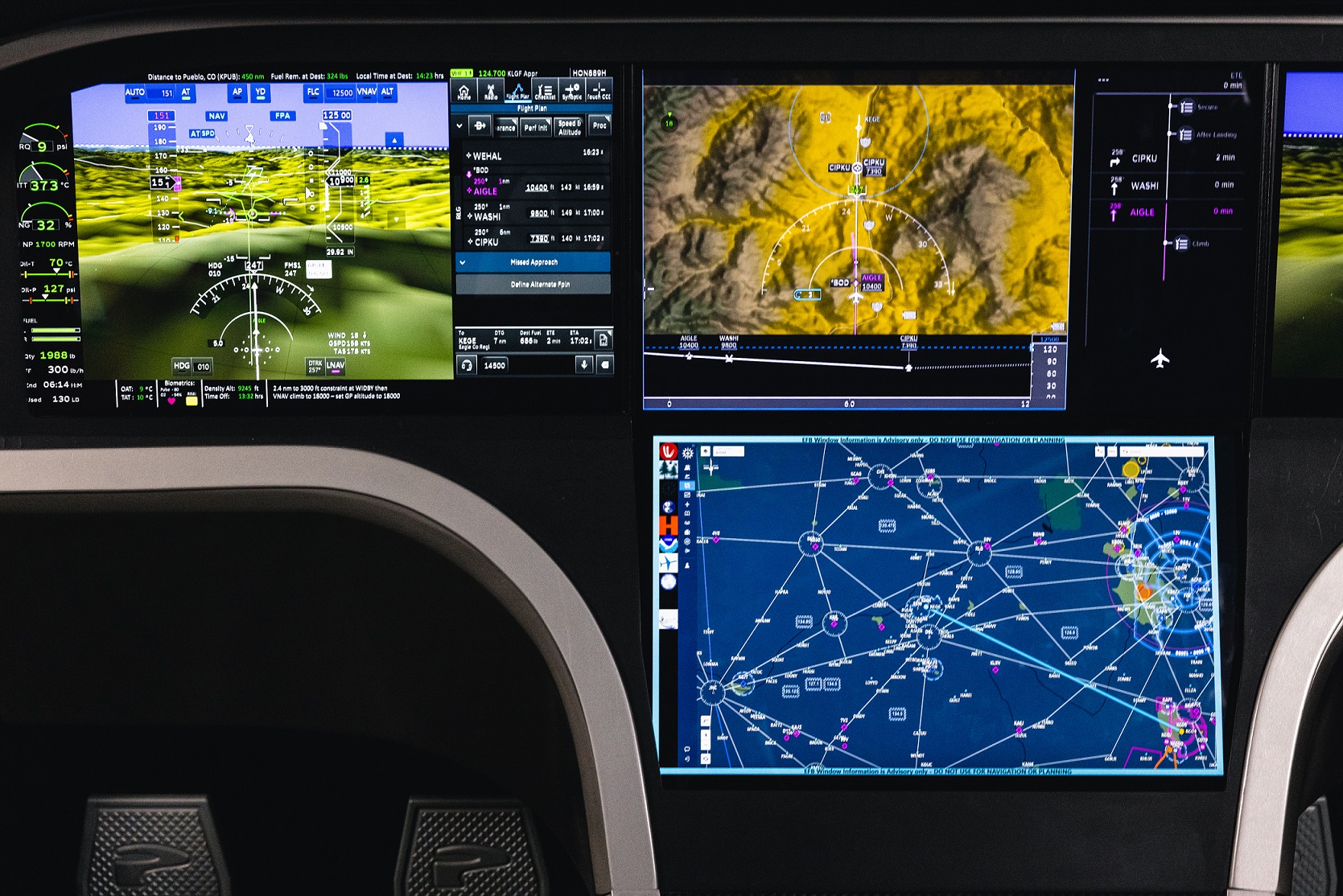Avionics, as well as new engines and airfoils, have powered business aviation’s historic advances, and Honeywell Aerospace blazed cockpit technology’s path forward with its integrated flight decks. Introduced with the SPZ8000 and Primus 1000 and 2000/2000XP, the Honeywell Primus family has improved with each succeeding generation, bringing more functionality and simplicity to pilot operations. The overarching goal: to make flight simple and safe. The products themselves came to define the modern flight deck during its evolution and today anchors the panels on business jets made by more than half a dozen manufacturers.
Now the sixth-generation Honeywell flight deck has arrived: Honeywell Anthem. Honeywell Anthem doesn’t simply redefine today’s modern integrated cockpit panel—it defines the flight deck of the future. For Honeywell, its customers, and business aviation, that future is here.
New Goals for a New Generation
Honeywell Anthem brings a new level of capability and possibility to OEMs and end users. Designed with future-proofed scalability, open architecture, and core connectivity to meet integrated flight deck needs across all platforms today, it also answers to needs and technologies to come.
“This is a giant leap into the vision of tomorrow, for both our OEM customers and end users,” said Vipul Gupta, vice president and general manager of Honeywell Aerospace Avionics, during a demonstration of Honeywell Anthem at the division’s Phoenix headquarters.
“We had three primary goals for Honeywell Anthem: deliver a step-change reduction in hardware size and weight; create a system designed with connectivity at its core; and provide a transformed user experience in the cockpit,” Gupta noted.
Honeywell has scored remarkably on all three fronts.
“We reduced both the hardware’s footprint and weight by half,” Gupta said, explaining, “We wanted a major size reduction primarily to give our OEM customers true cockpit design flexibility—it can be mounted anywhere in the cockpit. No avionics bays or cooling fans are necessary.”
Meanwhile, designers and engineers made connectivity as much a part of the flight deck as it is of our everyday lives. Gupta noted that while the Primus Epic platform remains extremely robust and capable, “We designed the basic architecture 20 years ago, and connectivity wasn’t even a word then. Today it is crucial for pilots, so we designed two-way connectivity into the architecture.”
The transformed user experience takes its cues from expectations shaped in homes and offices, and “on the fly,” between them.
“Our interactions with electronics are shaped by behaviors formed around our phones, tablets, and other digital devices,” communicated through touch and gesture, Gupta said. “We brought that touch modality into the cockpit. We want pilots to interact with the flight deck just like they would with their personal devices.”

For OEMs, Simplified Installations, and a Leap Forward in Branded Flight Deck Development
“We focused on installation flexibility,” said Gupta. Honeywell Anthem is scalable and can be right-sized for any cockpit or panel, and can support two, four, or more displays of multiple screen sizes, as the OEM chooses. These panels will all be fed by the same system—which OEMs can customize for the unique needs of their aircraft and customers—through simple, secure interface connections.
“It’s very easy to connect and disconnect,” said Gupta. “The back end has the graphics processing, all your other processing, and the IO [input/output] to drive the display. The front end is your display glass assembly and the things that go with it.”
This means that as new display technologies and interface methods develop, Honeywell Anthem will enable dramatic panel upgrades with what will amount to a cosmetic change in the fronting presentation.
Behind the hardware’s dramatic footprint reduction, Honeywell Anthem’s core processing unit architecture is contained on a single integrated chip that combines all its multiple functions and memory. The reduced size lets OEMs put the unit where their engineers and designers want it, virtually removing concerns about flight deck equipment requirements, and creating large potential savings on the production line. Besides requiring less power, the small processing unit produces little heat—it’s cooled passively, eliminating the need for fans.
Honeywell Anthem also enables a radically new approach to system customization and development, putting programming power directly in the hands of aircraft manufacturers and their system engineers. “This gives OEMs the autonomy to develop and certify their own applications in-house, without going to outside developers,” said Gupta. “We will provide the tools.”
That will dramatically shorten development cycles between new software updates and upgrades, and the team has been working closely with regulatory authorities since early in the Honeywell Anthem development cycle to ensure their support and approval for the new paths that Honeywell Anthem opens.
“We have engaged the FAA and have had several technical concept reviews already,” Gupta said. “We’ve submitted several TSO planning packages for approval, and we have also actually started our ESI [Early Supplier Integration] engagement.”
For Pilots and Operators, Unparalleled Capabilities and a User-friendly Experience
Honeywell Anthem’s ability to harness all the data it commands and its forward-thinking interface design philosophy give pilots a step-change in functionality and ease of operations. The interface has the same responsiveness and intuitiveness as the familiar consumer electronic devices they use daily. Super-smart onscreen prompts guide pilots simply and logically, not only supporting them in flight but turning them into accelerated learners on the ground. Under Honeywell Anthem’s intuitive instruction and reinforcing guidance, they can accomplish in hours what formerly took weeks of training or study.
Incorporating secure browser technology, Honeywell Anthem allows third-party applications and websites to run in the cockpit. One example Gupta showcased: “A pilot can, via a third-party app, display live weather images from the destination airport—and view beside them live radar imagery from the same airport.”
Honeywell Anthem also elevates synthetic vision, now a cockpit staple, to new levels, with significant advances in its utility in the airspace near airports. Gupta demonstrated how Honeywell Anthem can display waypoints in 3D vision that allow pilots to select any by touch, “and you will fly through them,” he said, adding, “This really scripts a compelling situational-awareness story for the pilot.”
Honeywell Anthem also brings the last word in easing pilot workload to the cockpit with Landing Assist, providing path guidance to a point 200 feet above centerline at a nearby airport. It is always available should a pilot become medically affected, fatigued, or confused, though still conscious and able to land safely. An Autoland feature is ready and waiting in the wings, Gupta said.
Honeywell Anthem eases pilots’ workloads before they even step on the aircraft. Its Mission Manager reduces preflight preparation time by some 45 minutes per flight by seamlessly integrating with popular electronic flight bag (EFB) planning applications, so pilots can create and transmit and load flight plans into the aircraft from anywhere.
Communication with the aircraft is further enabled by the industry’s first “always-on” cloud connectivity, built into Honeywell Anthem: in addition to agnostic support for satcom and other connectivity solutions, Honeywell Anthem has its own ground-based Wi-Fi connectivity system, allowing pilots and operators to log into the aircraft, load flight plans, check onboard system status, and perform all other functions as if at the aircraft.
The always-on access provides large benefits for operators, as well. “The connection becomes a two-way pipe between the airplane and the outside world in the operator’s larger ecosystem,” said Gupta. “They can load software, check the maintenance and the aircraft’s data status, and see what it’s doing and how it is any time.”
Into the Future
Honeywell is moving forward rapidly with Honeywell Anthem’s certification, and OEM customers—identities undisclosed—are concurrently certifying their branded Honeywell Anthem systems as well, Gupta said. “I don’t want to comment on their timelines but we will be ready to support all those certifications in the 2023 timeframe.”
Meanwhile, Honeywell’s plans for a world in which digital tools, high demand for pilots, autonomous vehicles, and other trends and technologies have recast the skies are far beyond the drawing boards. They include self-learning for ab initio pilots, single- or even no-pilot transport operations, support for largescale UMV operations, and more.
“They may not happen anytime soon,” Gupta said of what’s ahead, “but when they do, Honeywell Anthem will be ready.”
In this article








